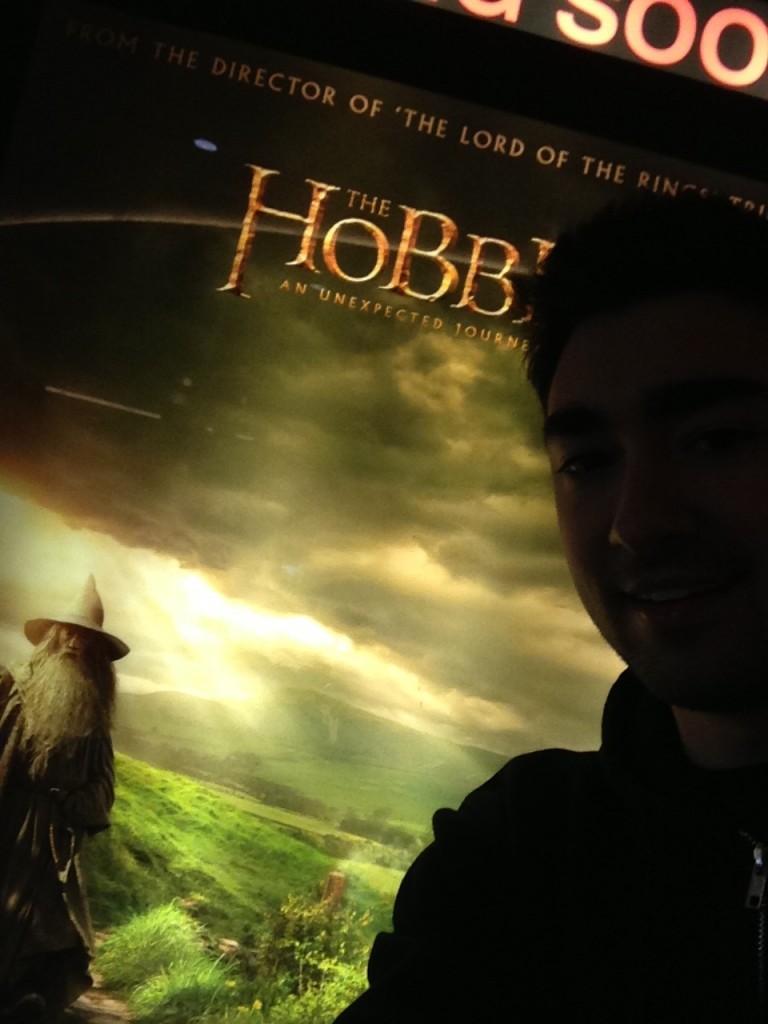
–Spoiler-free– (and yes that’s me)
Just got out of the THE HOBBIT. In a word, it was FANTASTIC. The story so far is really exciting and filled with the best characters. I can’t imagine anyone but Martin Freeman playing young Bilbo Baggins. Ian McKellen is back as Gandolf and he’s better than ever. And all 13 dwarves have their own distinct ways about themselves that I appreciate. The little men are led by Thorin Oakenshield, played by Richard Armitage, and he’s already a favorite. It was great seeing old characters return as well–Ian Holm (old Baggins), Elijah Wood (Frodo), Hugo Weaving (Elrond), Cate Blanchett (Galadriel), Christopher Lee (Saruman), Bret McKenzie (Lindir). And who can forget Gollum; Andy Serkis has perfected the once-human creature here. He looks incredible (especially his giant blue eyes and sharp mouth) and the scene in which he encounters Bilbo has to be my favorite one. It’s a mix of fear, humor, and curiosity. An honorable mention goes to composer Howard Shore whose original score for the film borrows classic sounds from LOTR but also adds a new layer of epic proportions (if you don’t have the dwarf song “Misty Mountains” stuck in your head when you’re walking out then something’s wrong). In the end I felt fully satisfied (I never thought I’d be returning to Tolkien and Jackson’s Middle Earth) and yet I was left with a wanting feeling for more. One down, two to go. Bilbo is going on an adventure, and I’m all in.
I saw the movie in 3D in 48 frames per second, or what Peter Jackson is calling High Frame Rate (HFR). First off, 3D was effective on all accounts: the depth it added to the picture had me immersed the entire time. The HFR took some getting used to. When the film starts right off the bat you notice that something is, well, “off” with the picture. One, it’s as if you’re watching a super HDTV–the sharpness and crispness and vividness of the picture is starkly different than anything I’ve ever experienced before in theatres. But in a good way. There are many scenes in the film that take a birds-eye view of vast landscapes all around Middle Earth and the HFR injects a sense of hyper-realism into these shots. My jaw dropped more than once upon witnessing such beautiful scenes. However, this new technology can be jarring at times in a not-so-good way. In the opening scene, when old Bilbo is in his hole in the ground writing his book for Frodo, his movements are fluid but the 48 frames make it seem as if he’s speeding through the process. It’s as if someone pressed the “fast-forward” button on the remote. And this is noticable throughout the film, especially during fast-paced action sequences. When things slow down (or during the aforementioned birds-eye shots) this is not as noticable. Some critics argue that the 48 frames takes away from the mistique of the movie. THE HOBBIT is a fantasy and the hyper-realism removes the layer of mystery by attempting to make things that aren’t real (i.e. orcs, trolls, giant flying birds), look real. Friends of mine compared it to how video game cut scenes look. I’m not sure if I totally agree with that, however. All in all, I say if you have the opportunity to visit a theatre that’s playing the movie in 48FPS you should absolutely experience it for yourself. Though I never really got used to the effect–which has its advantages (super HD crystal clear picture) and disadvantages (the “fast-forward” effect)–I was truly mesmorized and found myself lost in Middle Earth until the credits rolled at the end. Is 48FPS the future of movies like Jackson predicts? It’s too early to tell. Is the effect too much for a movie with fantasy roots? Perhaps. But in the end it’s worth it because it’s always fun to try new things.
In the words of Mr. Ebert, THE HOBBIT gets two big thumbs up and I highly recommend you go on the wonderfully crafted journey.